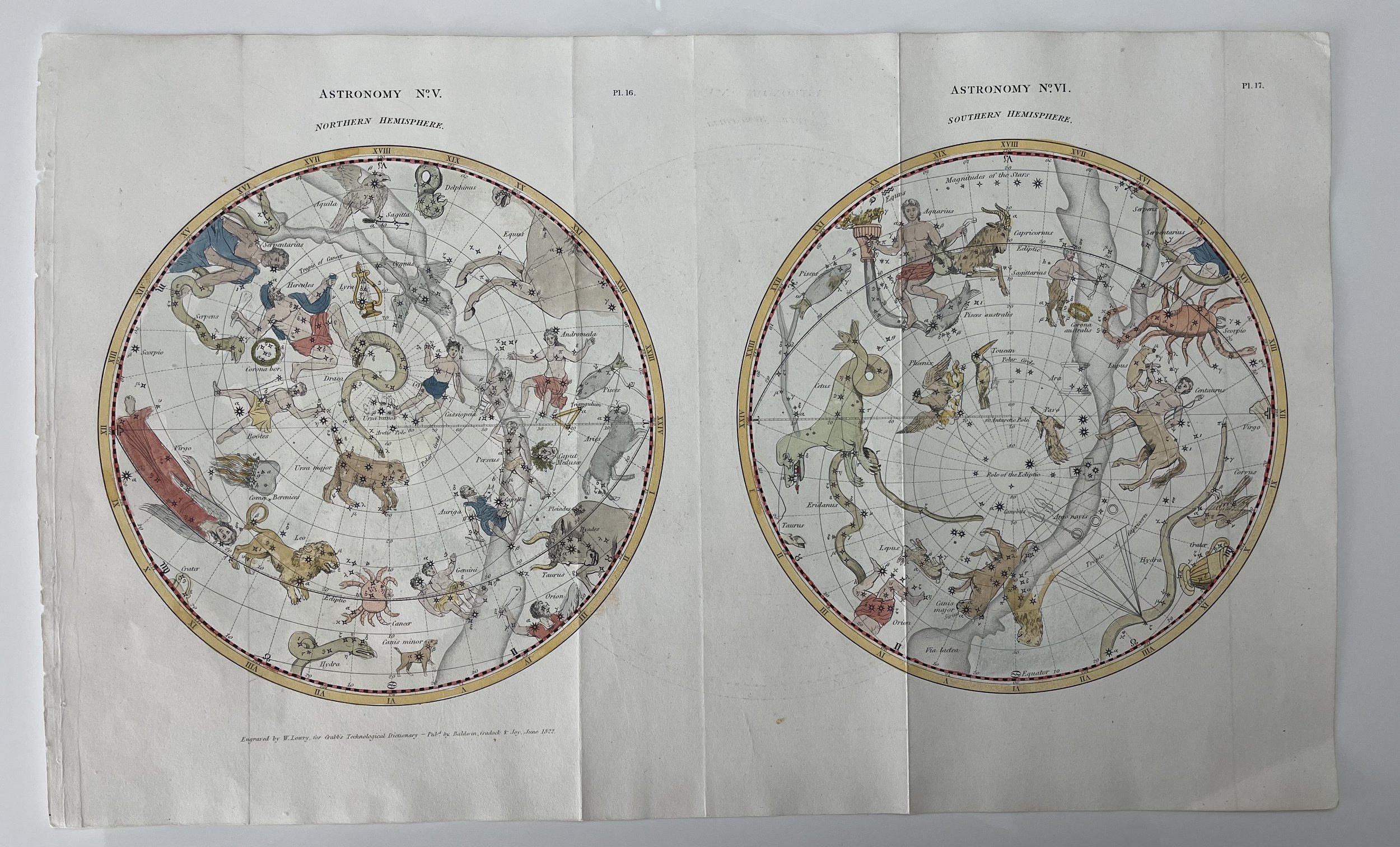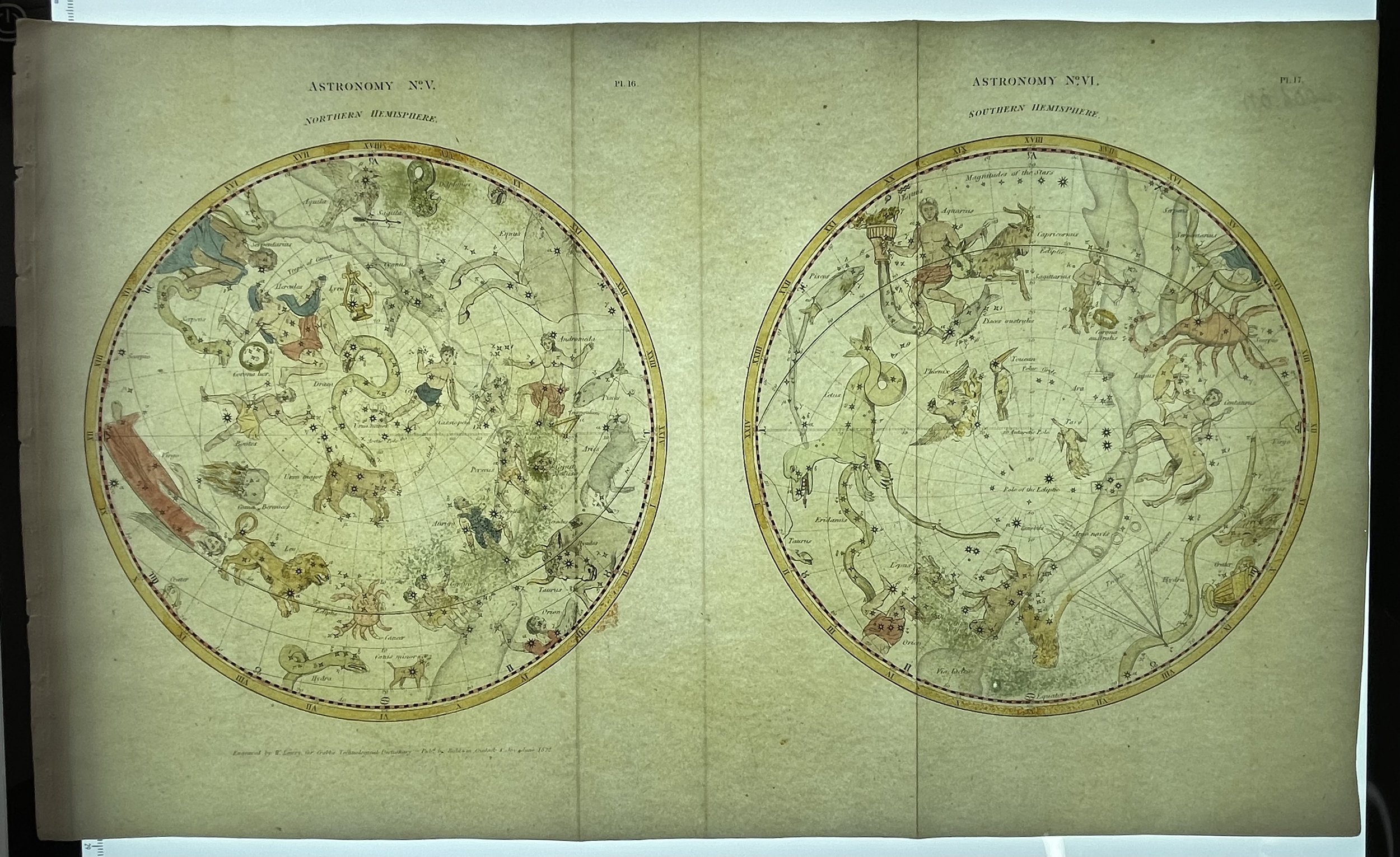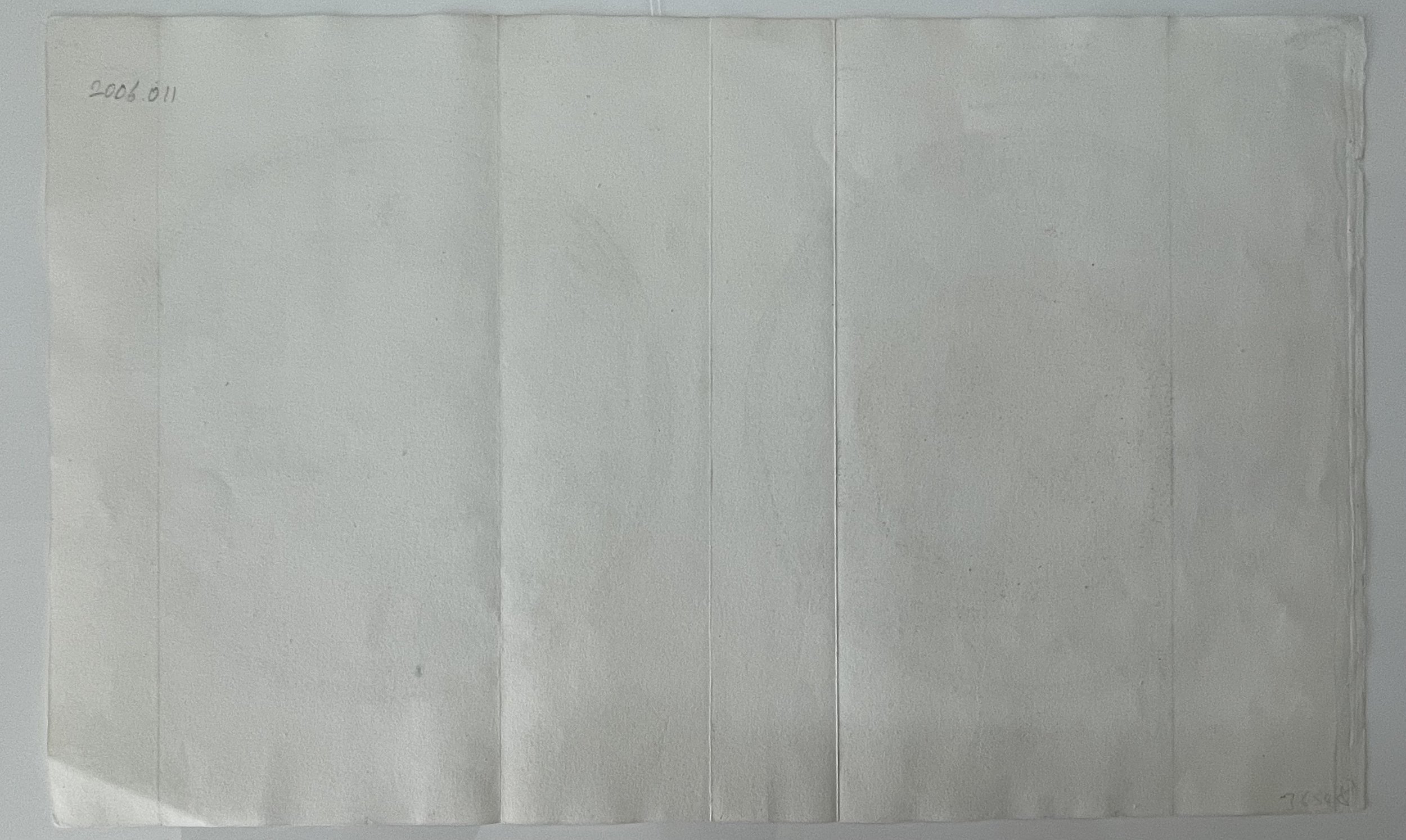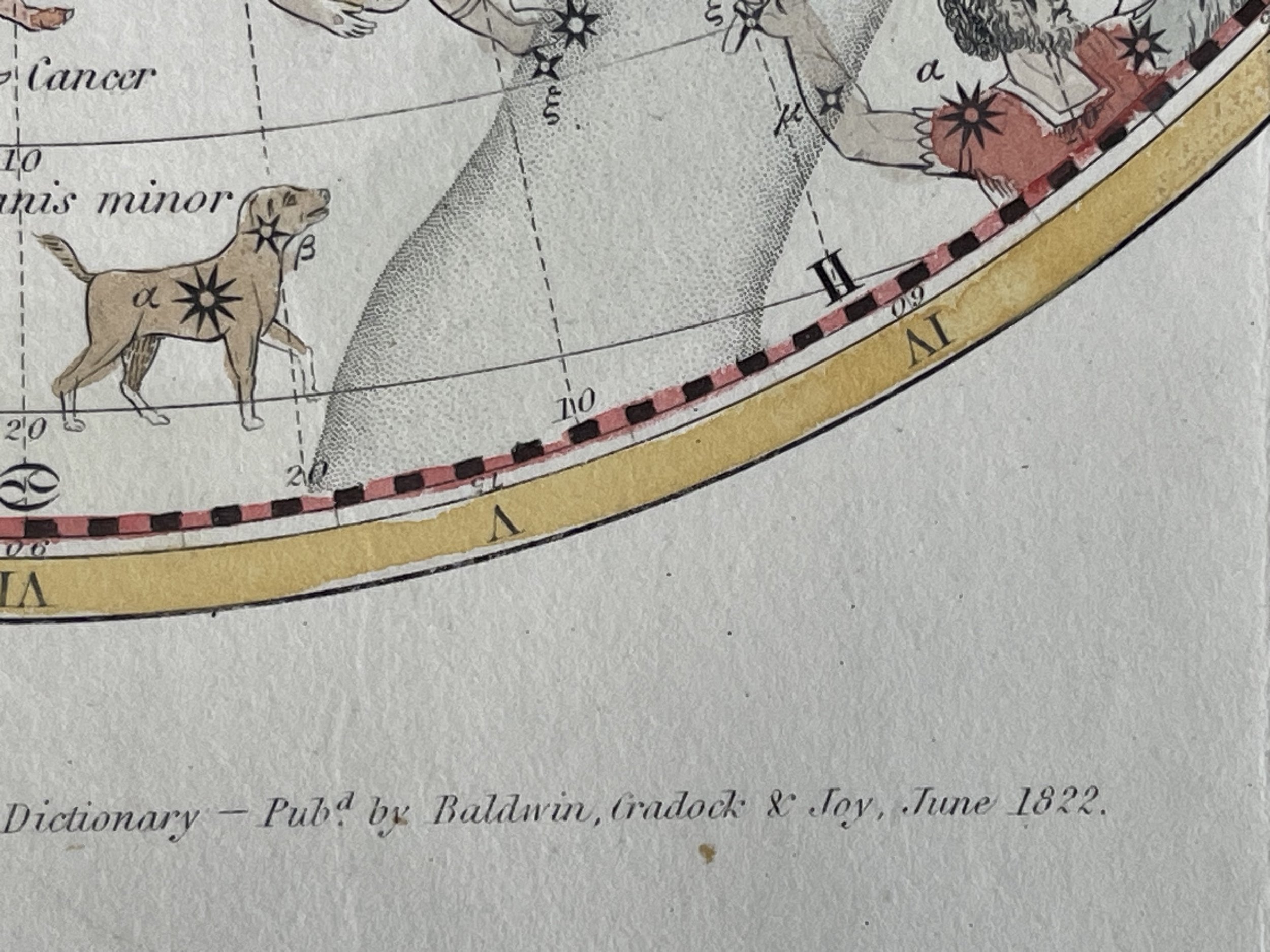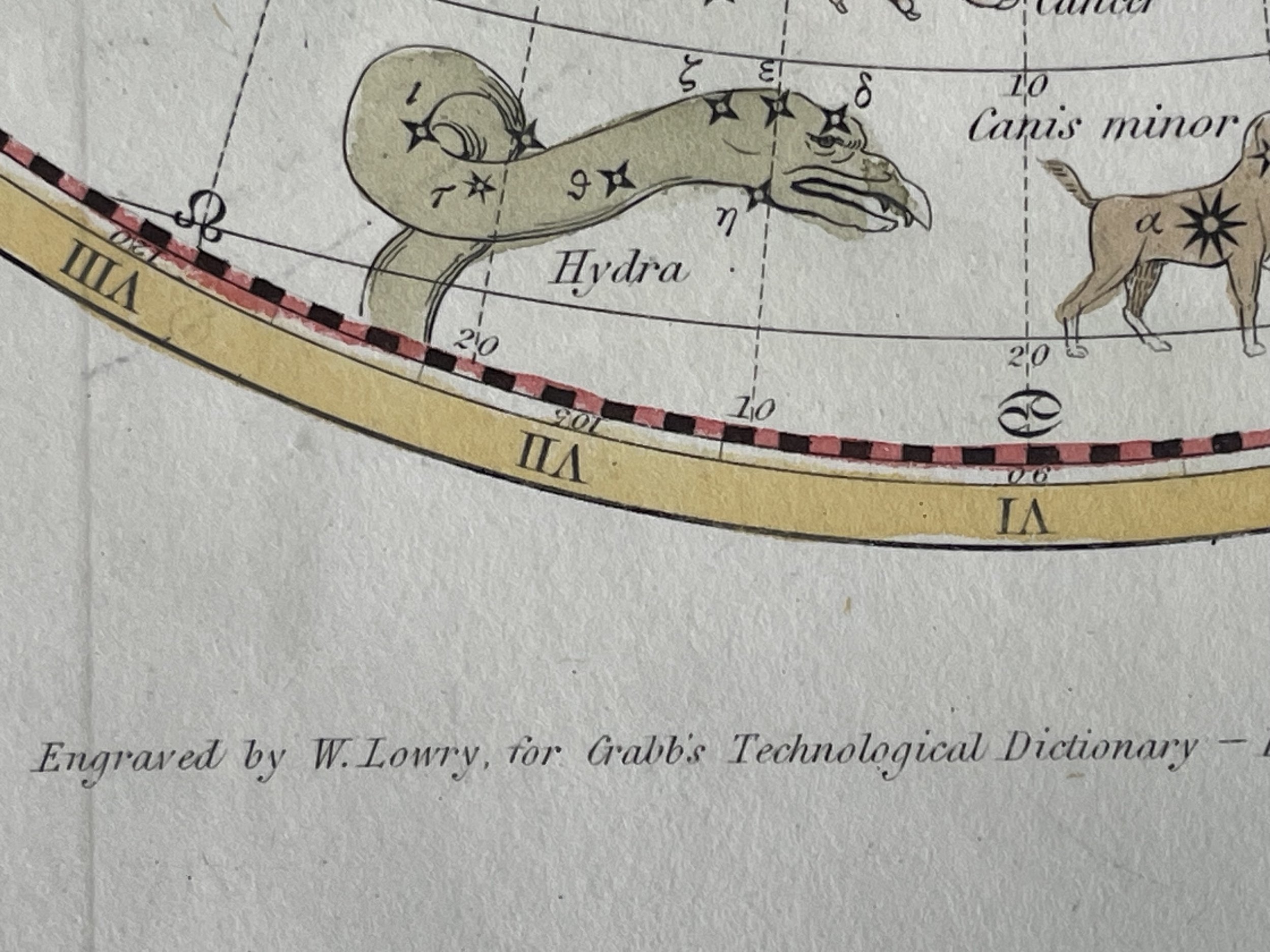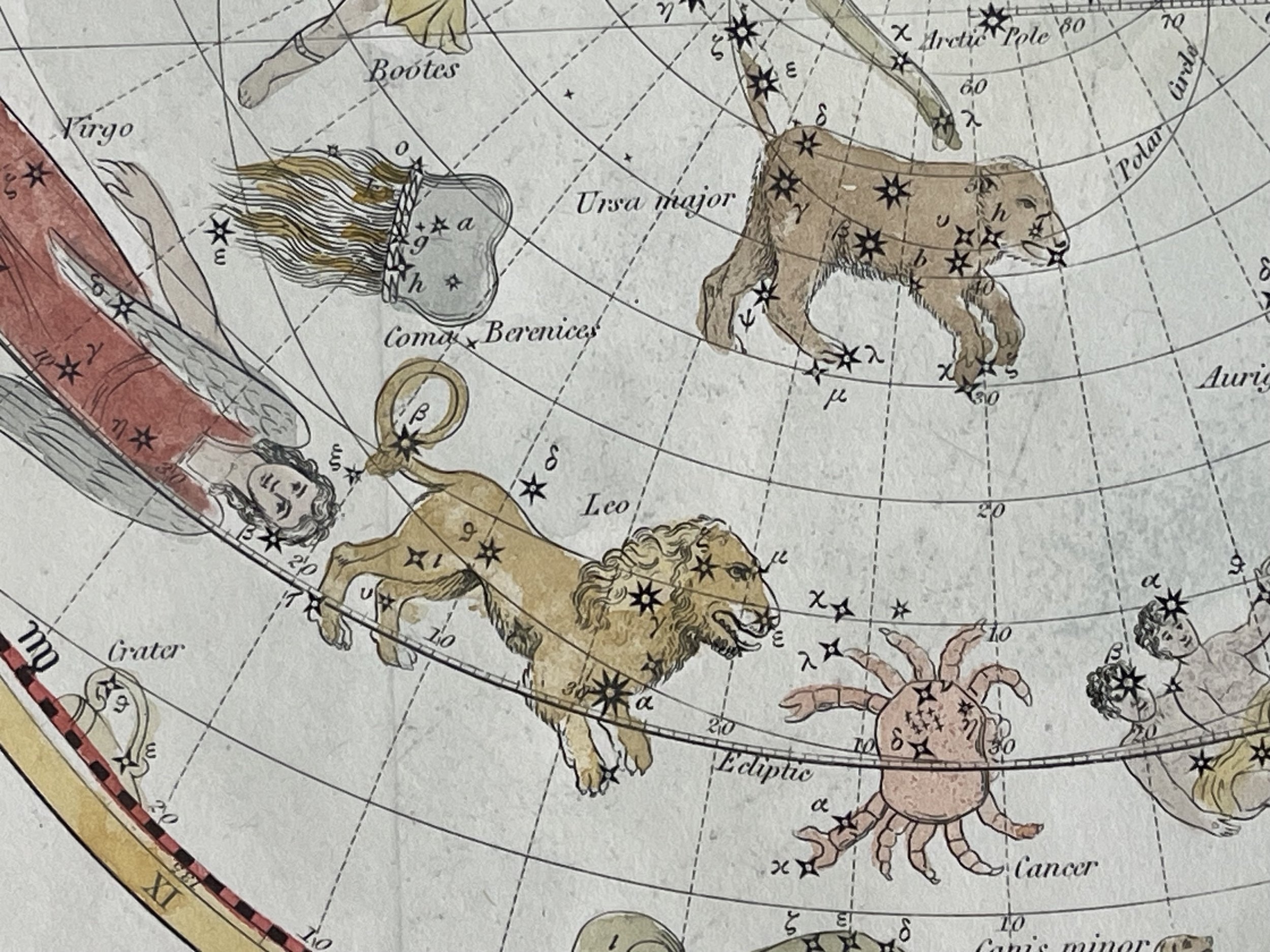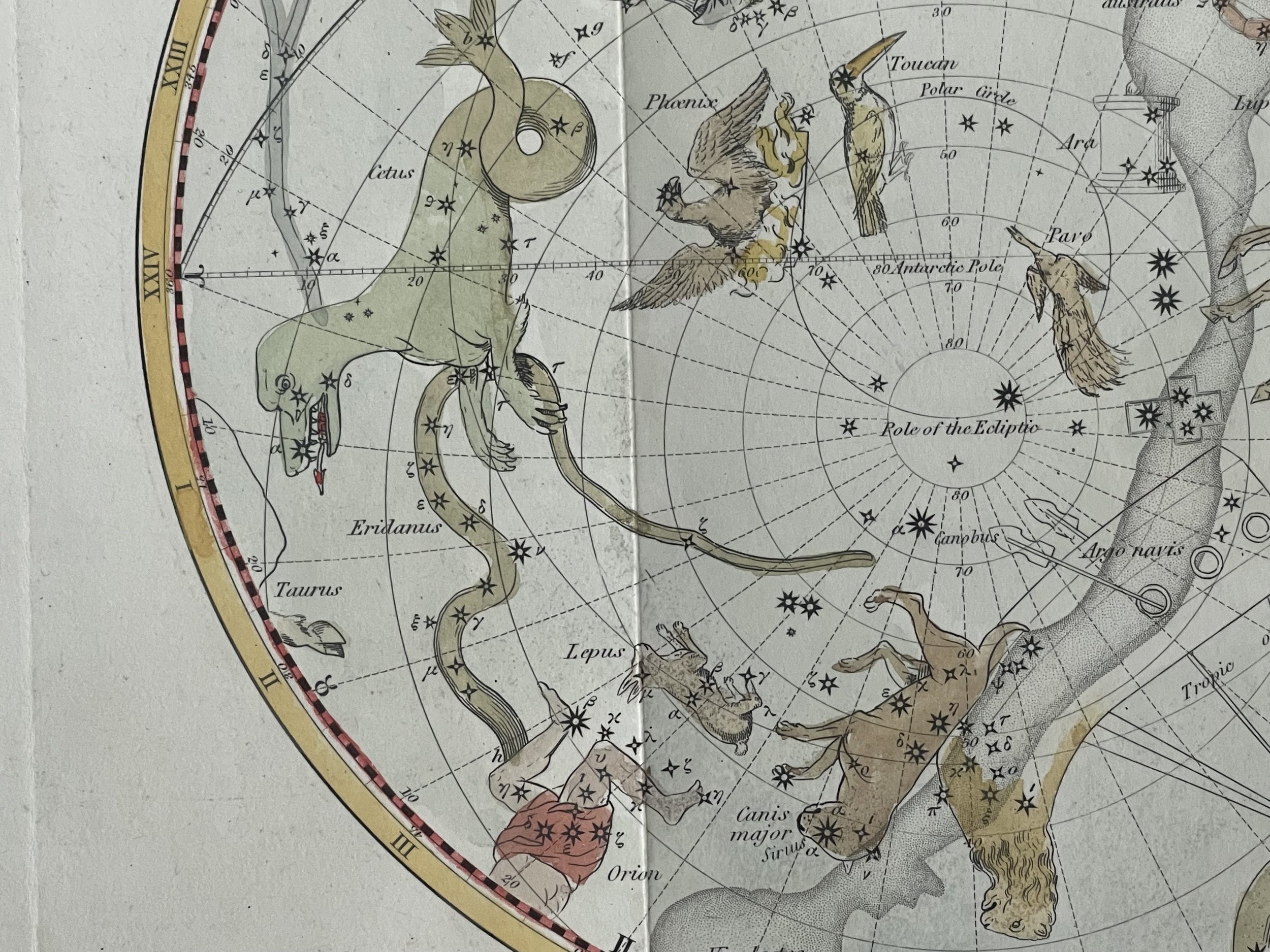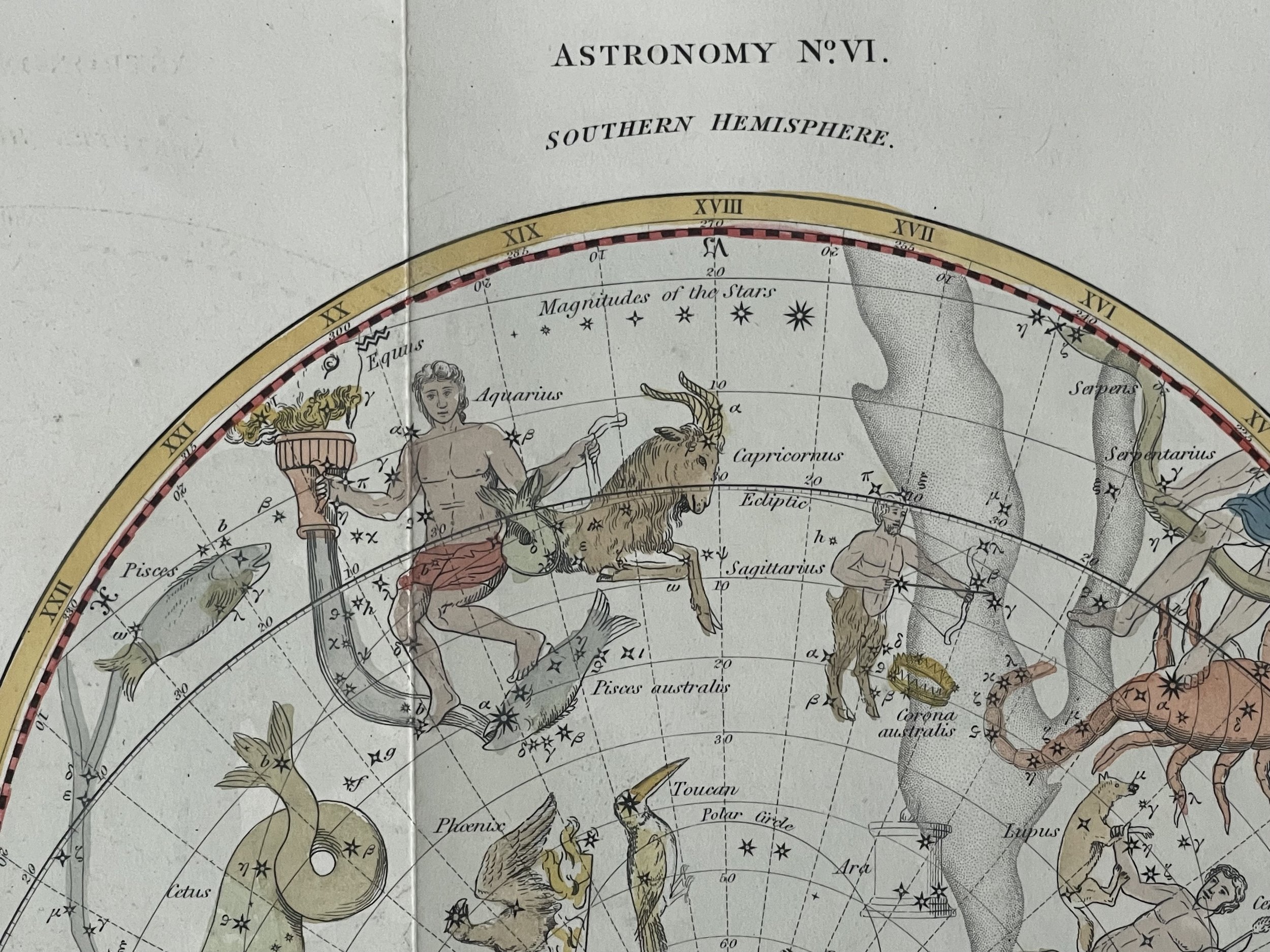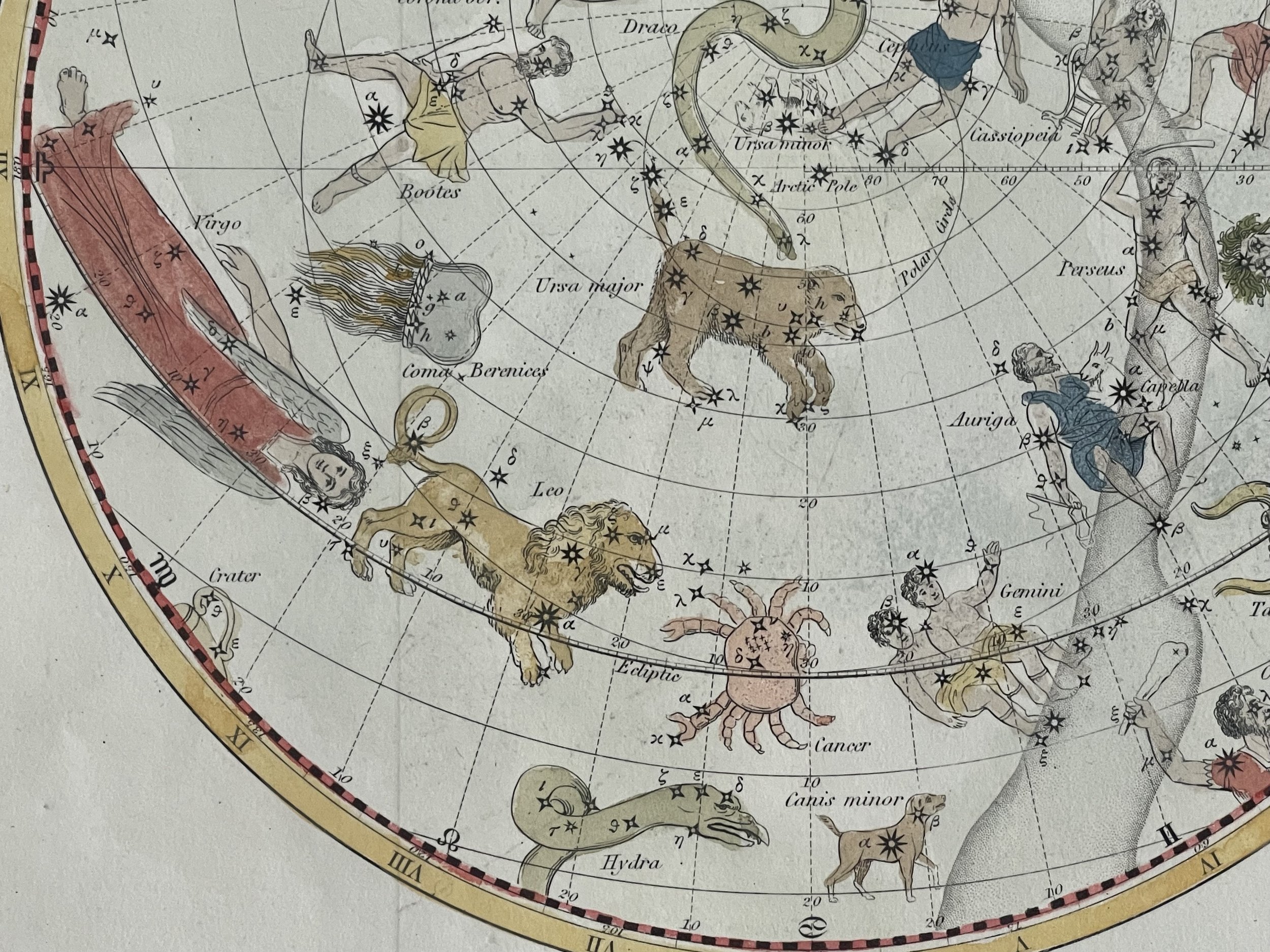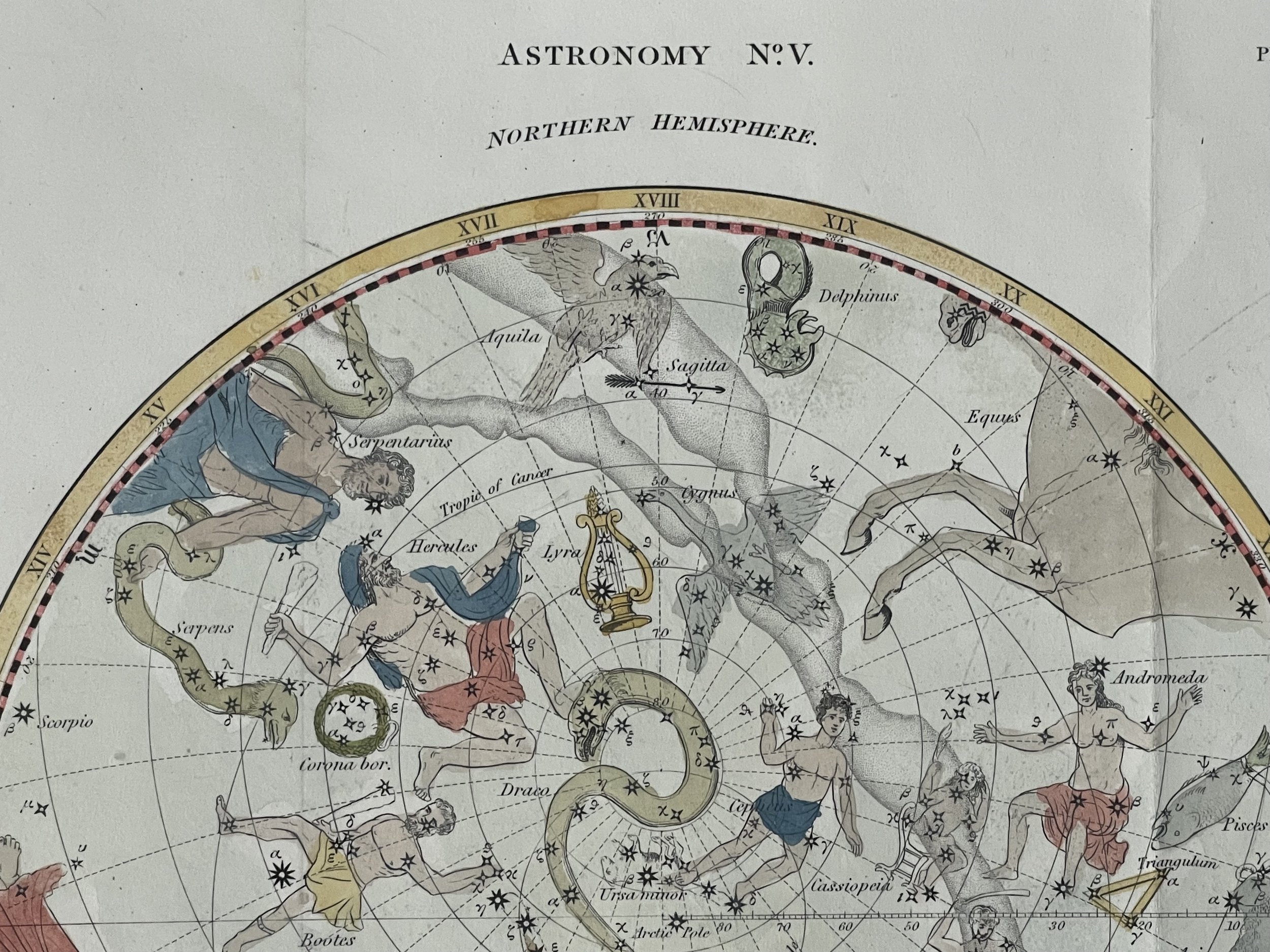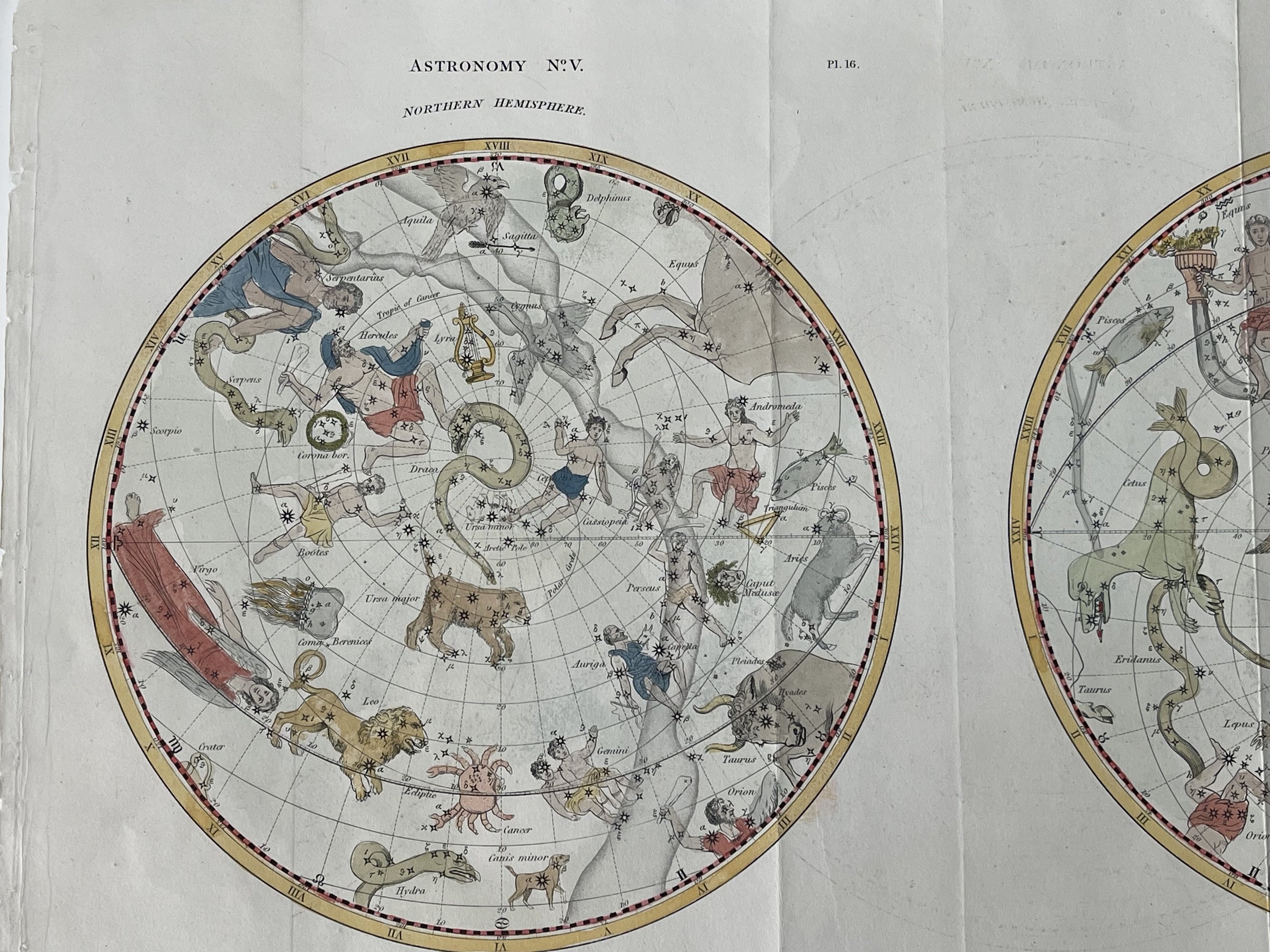Northern & Southern Celestial Hemispheres. - Wilson Lowry - 1822
Astronomy No.V. Northern Hemisphere; Astronomy No. VI. Southern Hemisphere.
On semi thick paper, this attractive and coloured double hemisphere celestial world map from ‘Universal Technological Dictionary or Familiar Explanation of the Terms used in all Arts and Sciences, by George Crabb, published by Baldwin, Cradock & Joy, London with fold.
Wilson Lowry FRS (24 January 1762 – 23 June 1824) was an English engraver.
He was born in Whitehaven, Cumberland, to Strickland Lowry, a portrait artist. After moving to Worcester, the Lowry family settled there. As a young boy, Wilson Lowry left home and went to work as a house painter in London and Arundel, Sussex. Upon his return home, he received some guidance in engraving from a skilled local craftsman.
At the age of 18, Lowry moved to London with an introduction to John Boydell, a print seller who offered him employment and introduced him to William Blizard, a surgeon. Blizard encouraged Lowry to pursue a career in surgery and he underwent four years of training, but ultimately abandoned it.
Lowry studied under landscape engraver John Browne and received further education at the Royal Academy Schools. He developed his own specialised tools to assist in his work, including a ruling machine in 1790, a device for creating elliptical curves in 1801, and another for making perspective drawings in 1806. He was also the first engraver to use diamond points and discover a corrosive fluid for etching onto steel plates.
Lowry's area of expertise was in engraving architectural and mechanical subjects, particularly in perspective views of machinery. His work was published in Tilloch's Philosophical Magazine, the Journal of the Society of Arts, and various other encyclopaedias and publications. His most famous work was for Rees's Cyclopædia from 1802 to 1819, but he also contributed to other encyclopaedias such as Pantologia and the British Encyclopaedia, or Dictionary of Arts and Sciences.
Lowry was a founding member of the Geological Society and was later elected a Fellow of the Royal Society in 1812. He passed away at his home in Great Titchfield Street, London.
Lowry was married twice, first to Miss Porter with whom he had two daughters. His daughter Matilda went on to become a portrait painter. He then married mineralogist Rebecca (1761–1848), daughter of Abraham Delvalle. She came from a Sephardic Jewish family of successful snuff and tobacco merchants who had become British citizens. Her sister, Abigail Delvalle, was the mother of economist David Ricardo. Lowry and Rebecca had a son, Joseph Wilson Lowry, and a daughter, Delvalle Lowry, who married landscape painter John Varley.
George Crabb (1778–1851) was an English legal and miscellaneous writer.
He was born on 8 December 1778 at Palgrave, Suffolk. He was educated at a school at Diss and under a private tutor. He began as a medical student but became assistant to a bookseller. This he also shortly dropped to study for the ministry at Northampton but experienced a sudden change in his religious views.
In 1797 he came to London, and after his marriage to Maria Southgate, who subsequently edited ‘Tales for Children from the German,’ became classical master at Thorp Arch School, Yorkshire. To master German language, he went in 1801 to Bremen, where he supported himself by teaching English.
In 1814 he entered Magdalen Hall, Oxford, as a gentleman commoner, and shortly thereafter published his oft reprinted Dictionary of English Synonyms. He graduated with a B.A. in 1821 and M.A. in 1822, with mathematical honours. He was called to the bar at the Inner Temple in 1829, and adopted the practice of conveyancer and chamber counsel, but on account of his shy manner was not very successful. He became a recluse and died on 4 December 1851.
Robert Baldwin and Cradock (fl. c. 1820 - 1890)
Baldwin and Cradock were a London-based publishing company that operated during the early to mid-19th century, with a period of activity dating from around 1810 to 1860. They are most renowned for their production of the pioneering subscription atlas of the Society for the Diffusion of Useful Knowledge. During their lifespan, they also released the magnificent New General Atlas by John Thomson from approximately 1814 to 1820. While specializing in cartography, the firm also had a diverse range of publishing interests, including books, broadsides, and even a stake in Blackwood's Magazine. Their headquarters were located at 47 Paternoster Row in London, England. Additionally, their publications were sometimes released under the imprints Baldwin, Cradock, and Joy, as well as Cradock and Joy.
Astronomy No.V. Northern Hemisphere; Astronomy No. VI. Southern Hemisphere.
On semi thick paper, this attractive and coloured double hemisphere celestial world map from ‘Universal Technological Dictionary or Familiar Explanation of the Terms used in all Arts and Sciences, by George Crabb, published by Baldwin, Cradock & Joy, London with fold.
Wilson Lowry FRS (24 January 1762 – 23 June 1824) was an English engraver.
He was born in Whitehaven, Cumberland, to Strickland Lowry, a portrait artist. After moving to Worcester, the Lowry family settled there. As a young boy, Wilson Lowry left home and went to work as a house painter in London and Arundel, Sussex. Upon his return home, he received some guidance in engraving from a skilled local craftsman.
At the age of 18, Lowry moved to London with an introduction to John Boydell, a print seller who offered him employment and introduced him to William Blizard, a surgeon. Blizard encouraged Lowry to pursue a career in surgery and he underwent four years of training, but ultimately abandoned it.
Lowry studied under landscape engraver John Browne and received further education at the Royal Academy Schools. He developed his own specialised tools to assist in his work, including a ruling machine in 1790, a device for creating elliptical curves in 1801, and another for making perspective drawings in 1806. He was also the first engraver to use diamond points and discover a corrosive fluid for etching onto steel plates.
Lowry's area of expertise was in engraving architectural and mechanical subjects, particularly in perspective views of machinery. His work was published in Tilloch's Philosophical Magazine, the Journal of the Society of Arts, and various other encyclopaedias and publications. His most famous work was for Rees's Cyclopædia from 1802 to 1819, but he also contributed to other encyclopaedias such as Pantologia and the British Encyclopaedia, or Dictionary of Arts and Sciences.
Lowry was a founding member of the Geological Society and was later elected a Fellow of the Royal Society in 1812. He passed away at his home in Great Titchfield Street, London.
Lowry was married twice, first to Miss Porter with whom he had two daughters. His daughter Matilda went on to become a portrait painter. He then married mineralogist Rebecca (1761–1848), daughter of Abraham Delvalle. She came from a Sephardic Jewish family of successful snuff and tobacco merchants who had become British citizens. Her sister, Abigail Delvalle, was the mother of economist David Ricardo. Lowry and Rebecca had a son, Joseph Wilson Lowry, and a daughter, Delvalle Lowry, who married landscape painter John Varley.
George Crabb (1778–1851) was an English legal and miscellaneous writer.
He was born on 8 December 1778 at Palgrave, Suffolk. He was educated at a school at Diss and under a private tutor. He began as a medical student but became assistant to a bookseller. This he also shortly dropped to study for the ministry at Northampton but experienced a sudden change in his religious views.
In 1797 he came to London, and after his marriage to Maria Southgate, who subsequently edited ‘Tales for Children from the German,’ became classical master at Thorp Arch School, Yorkshire. To master German language, he went in 1801 to Bremen, where he supported himself by teaching English.
In 1814 he entered Magdalen Hall, Oxford, as a gentleman commoner, and shortly thereafter published his oft reprinted Dictionary of English Synonyms. He graduated with a B.A. in 1821 and M.A. in 1822, with mathematical honours. He was called to the bar at the Inner Temple in 1829, and adopted the practice of conveyancer and chamber counsel, but on account of his shy manner was not very successful. He became a recluse and died on 4 December 1851.
Robert Baldwin and Cradock (fl. c. 1820 - 1890)
Baldwin and Cradock were a London-based publishing company that operated during the early to mid-19th century, with a period of activity dating from around 1810 to 1860. They are most renowned for their production of the pioneering subscription atlas of the Society for the Diffusion of Useful Knowledge. During their lifespan, they also released the magnificent New General Atlas by John Thomson from approximately 1814 to 1820. While specializing in cartography, the firm also had a diverse range of publishing interests, including books, broadsides, and even a stake in Blackwood's Magazine. Their headquarters were located at 47 Paternoster Row in London, England. Additionally, their publications were sometimes released under the imprints Baldwin, Cradock, and Joy, as well as Cradock and Joy.
Astronomy No.V. Northern Hemisphere; Astronomy No. VI. Southern Hemisphere.
On semi thick paper, this attractive and coloured double hemisphere celestial world map from ‘Universal Technological Dictionary or Familiar Explanation of the Terms used in all Arts and Sciences, by George Crabb, published by Baldwin, Cradock & Joy, London with fold.
Wilson Lowry FRS (24 January 1762 – 23 June 1824) was an English engraver.
He was born in Whitehaven, Cumberland, to Strickland Lowry, a portrait artist. After moving to Worcester, the Lowry family settled there. As a young boy, Wilson Lowry left home and went to work as a house painter in London and Arundel, Sussex. Upon his return home, he received some guidance in engraving from a skilled local craftsman.
At the age of 18, Lowry moved to London with an introduction to John Boydell, a print seller who offered him employment and introduced him to William Blizard, a surgeon. Blizard encouraged Lowry to pursue a career in surgery and he underwent four years of training, but ultimately abandoned it.
Lowry studied under landscape engraver John Browne and received further education at the Royal Academy Schools. He developed his own specialised tools to assist in his work, including a ruling machine in 1790, a device for creating elliptical curves in 1801, and another for making perspective drawings in 1806. He was also the first engraver to use diamond points and discover a corrosive fluid for etching onto steel plates.
Lowry's area of expertise was in engraving architectural and mechanical subjects, particularly in perspective views of machinery. His work was published in Tilloch's Philosophical Magazine, the Journal of the Society of Arts, and various other encyclopaedias and publications. His most famous work was for Rees's Cyclopædia from 1802 to 1819, but he also contributed to other encyclopaedias such as Pantologia and the British Encyclopaedia, or Dictionary of Arts and Sciences.
Lowry was a founding member of the Geological Society and was later elected a Fellow of the Royal Society in 1812. He passed away at his home in Great Titchfield Street, London.
Lowry was married twice, first to Miss Porter with whom he had two daughters. His daughter Matilda went on to become a portrait painter. He then married mineralogist Rebecca (1761–1848), daughter of Abraham Delvalle. She came from a Sephardic Jewish family of successful snuff and tobacco merchants who had become British citizens. Her sister, Abigail Delvalle, was the mother of economist David Ricardo. Lowry and Rebecca had a son, Joseph Wilson Lowry, and a daughter, Delvalle Lowry, who married landscape painter John Varley.
George Crabb (1778–1851) was an English legal and miscellaneous writer.
He was born on 8 December 1778 at Palgrave, Suffolk. He was educated at a school at Diss and under a private tutor. He began as a medical student but became assistant to a bookseller. This he also shortly dropped to study for the ministry at Northampton but experienced a sudden change in his religious views.
In 1797 he came to London, and after his marriage to Maria Southgate, who subsequently edited ‘Tales for Children from the German,’ became classical master at Thorp Arch School, Yorkshire. To master German language, he went in 1801 to Bremen, where he supported himself by teaching English.
In 1814 he entered Magdalen Hall, Oxford, as a gentleman commoner, and shortly thereafter published his oft reprinted Dictionary of English Synonyms. He graduated with a B.A. in 1821 and M.A. in 1822, with mathematical honours. He was called to the bar at the Inner Temple in 1829, and adopted the practice of conveyancer and chamber counsel, but on account of his shy manner was not very successful. He became a recluse and died on 4 December 1851.
Robert Baldwin and Cradock (fl. c. 1820 - 1890)
Baldwin and Cradock were a London-based publishing company that operated during the early to mid-19th century, with a period of activity dating from around 1810 to 1860. They are most renowned for their production of the pioneering subscription atlas of the Society for the Diffusion of Useful Knowledge. During their lifespan, they also released the magnificent New General Atlas by John Thomson from approximately 1814 to 1820. While specializing in cartography, the firm also had a diverse range of publishing interests, including books, broadsides, and even a stake in Blackwood's Magazine. Their headquarters were located at 47 Paternoster Row in London, England. Additionally, their publications were sometimes released under the imprints Baldwin, Cradock, and Joy, as well as Cradock and Joy.
Code : A897
Cartographer : Cartographer / Engraver / Publisher: Wilson Lowry
Date : Publication Place / Date - Circa 1822
Size : Sheet size: approx 44 x 27 Cm
Availability : Available
Type - Genuine - Antique
Grading A
Where Applicable - Folds as issued. Light box photo shows the folio leaf centre margin hinge ‘glue’, this is not visible otherwise.
Tracked postage, in casement. Please contact me for postal quotation outside of the UK.
